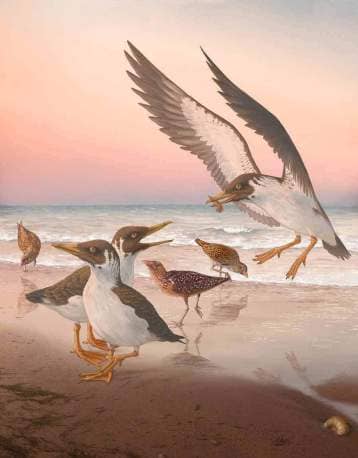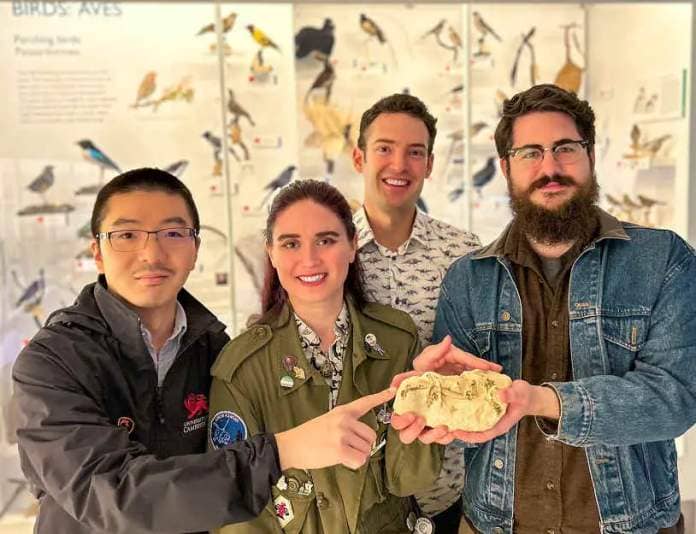A new dino-bird fossil has overturned more than a century of accepted wisdom about how modern birds evolved. It comes down to a key beak feature.
Modern birds fall into two infraclasses: neognaths and palaeognaths.
Almost all of today’s roughly 11,000 bird species are neognaths, or “modern jaws”. The palate (roof of mouth) structure of neognath jaws is connected by a mobile joint, and a number of the jawbones are reduced. This makes their beaks more dextrous, which is helpful in nest-building, grooming, food gathering, and defence.
Palaeognathae palates are considered more primitive and reptilian, with fused palate bones. There are only a few dozen living birds which fall into this second clade, including emus, ostriches and kiwis.
For nearly 150 years, palaeontologists have assumed that mobile beaks evolved after the mass extinction that saw the demise of the non-avian dinosaurs 66 million years ago. The theory – as well as the split in living birds between ‘new’ and ‘old’ jaws – was posited by British biologist Thomas Huxley, an avid supporter of Charles Darwin’s theory of evolution, in 1867.
Read more: Is it a bird? Is it a plane? It’s a dinosaur with the body of a modern bird, but a head like T. rex
Now, a new analysis of a fossil discovered in the 1990s on the border between Belgium and the Netherlands challenges this hypothesis.


The ancient bird, named Janavis finalidens, lived in the last days of the dinosaurs at the end of the Cretaceous period 66 million years ago.
At around 1.5 kilograms, Janavis was the size of a modern vulture and was a seabird living in the then tropical islets that made up what is now Europe. Its larger size is probably what caused Janavis’s demise as most animals to survive the mass extinction were small creatures which had to eat little to survive.
Like other birds present during the ‘Age of Dinosaurs’, Janavis had teeth. But this was no ordinary prehistoric bird. Reinvestigation of Janavis fossils first studied in 2002 corrected previous misconceptions.
Using CT scans to peer into the rock surrounding the fragile fossils, a University of Cambridge team found that a piece, previously thought to be a shoulder bone, is actually a key portion of the palate. This discovery shows that Janavis had a modern, mobile beak.
“Since this fossil was first described, we’ve started using CT scanning on fossils, which enables us to see through the rock and view the entire fossil,” says lead author of a paper published on the analysis in Nature, Dr Juan Benito, who spoke to SciTechDaily. “We had high hopes for this fossil – it was originally said to have skull material, which isn’t often preserved, but our CT scans didn’t show anything that looked like it came from a skull, so we gave up and put the fossil aside.”
But Benito and the team checked the fossil again during COVID-19 lockdowns. “The earlier descriptions of the fossil just didn’t make sense – there was a bone I was really puzzled by. I couldn’t see how what was first described as a shoulder bone could actually be a shoulder bone,” he said.
Research team leader Dr Daniel Field says the analysis shows that: “Evolution doesn’t happen in a straight line.”
“This fossil shows that the mobile beak – a condition we had always thought post-dated the origin of modern birds, actually evolved before modern birds existed. We’ve been completely backwards in our assumptions of how the modern bird skull evolved for well over a century,” Field adds.
Read more: Powered flight in feathered dinosaurs confirmed in Chinese fossils showing muscle imprints
A key reason Huxley’s assumption persisted for so long “is that we haven’t had any well-preserved fossil bird palates from the period when modern birds originated,” Field says on SciTechDaily.
The fossil palate bone is “extremely similar to those of living chickens and ducks” according to PhD student Pen-Chen Kuo.


“Surprisingly, the bird palate bones that are the least similar to that of Janavis are from ostriches and their kin,” says another PhD student in Fields’s team Klara Widrig.
The find therefore suggests that the common ancestor of modern birds may have been a neognath, which would indicate that palaeognaths like ostriches might have “evolved backwards”, reverting to a more primitive jaw morphology.
![]()


